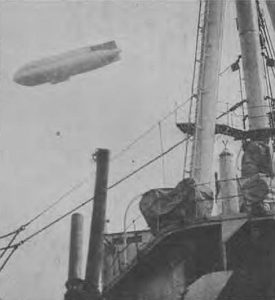- Author
- Issacs, Keith, AFC, ARAeS, Group Captain, RAAF (Retd)
- Subjects
- History - WW1, Naval Aviation
- Tags
-
- RAN Ships
- HMAS Melbourne I, HMAS Sydney I, HMAS Australia I
- Publication
- March 1974 edition of the Naval Historical Review (all rights reserved)
Sopwith Ship’s Camel
The Sopwith 2F.1 Camel was a shipboard development of the Sopwith F.1 Camel which operated with the Australian Flying Corps. Both the F.1 and 2F.1 single-seat scouts served with the Royal Naval Air Service; in fact five naval F.1s from Dunkirk were the first Camels to go into action when, on 4 July 1917, they attacked a Gotha formation returning from a raid over England. The prototype 2F.1, or Ship’s Camel, first flew in March 1917, and by October 1918 112 of them were aboard ships of the Grand Fleet. The rear half of the 2F.1 fuselage was detachable to permit storage on ships, and the aircraft usually carried a single Vickers gun in the port position, together with a Lewis gun mounted above the centre section, instead of the twin Vickers guns of the F.1. The 2F.1 Camel mainly operated with a normal wheel undercarriage and took off from the decks of carriers, gun-platforms on cruisers and battleships, and lighters towed by destroyers. The main operation role of the 2F.1 was to intercept Zeppelins over the North Sea, and on 11 August 1918, Zeppelin L.53 was shot down by Lieutenant S.D. Culley, whose Camel, N.6812, is preserved in the Imperial War Museum. Zeppelins were also attacked in their sheds, as for example on 19 July 1918, when several 2F.1s from the aircraft carrier HMS Furious destroyed Zeppelins L.54 and L.60 at Tondern. 2F.1 Camels were used as well in experimental launchings from the British airship R.23 in 1918, although the Germans had flown an Albatros D III scout from Zeppelin L.35 a few months earlier on 25-26 January.
After the first flight of a Sopwith Pup from Sydney on 8 December 1917, Captain Dumaresq was anxious to test the cruiser’s revolving platform with a more modern aircraft. On 14 December a signal was despatched from Sydney to the Scapa Flow aerodrome at Smoogroo: ‘As Dublin’s pilot has to return shortly . . . requested that Campania may be asked to supply a pilot and Camel, or standard Pup, complete with 2 mechanics, to Sydney.’ Two days later, presumably after much worried thought, a perplexed query came back, ‘Does Camel refer to part of equipment or to a particular type of aeroplane?’ Sydney promptly and patiently spelt out the answer; ‘The machine referred to is a Sopwith Camel aeroplane. It is the latest standard fighter and has succeeded the Pup.’ Perhaps in all fairness to the Navy shore staff they could not be blamed for querying why an Australian cruiser, anchored in the middle of Scapa Flow, was asking for a camel to be delivered to the ship – they probably thought it was some kind of delicacy the wild colonials served for breakfast. Undeterred, Dumaresq persisted in his endeavours and, after an invitation to the captain of the carrier Campania to be his dinner guest, eventually got his Camel.

It would appear that Sydney received her Camel about the same time that Australia took aboard her 2F.1 in February 1918. Both ships began to use their aircraft as often as possible, and Sydney found her revolving platform to be a great success. In Australia’s case the Camel was launched from the aircraft ramp over the amidships 15-inch guns, first on the starboard ‘Q’ turret, and later from the port ‘P’ turret. Generally a Camel occupied one of these positions, and a 1½ Strutter was carried on the other ramp. However, on at least one occasion, Australia operated two Camel aircraft together, for the Ship’s Log of 22 October 1918 recorded that one Camel was flown off ‘P’ turret at 9.10 a.m., and another was launched from ‘Q’ turret at 9.20 a.m. Meanwhile, in March 1918 Melbourne had been fitted with a revolving platform, similar to that installed in Sydney.
Her pilot, Flight Lieutenant L.B. Gibson, Royal Air Force, arrived on 14 April and made the first flight on 10 May.
On 1 June the Camels from Sydney and Melbourne were launched on their first operational flights. A large naval force had assembled to carry out a raid into Heligoland Bight and included the Second Light Cruiser Squadron (with the two Australian cruisers), followed by the two large cruisers HM Ships Courageous and Glorious, fitted out to carry aircraft, and the First Battle Cruiser Squadron led by Admiral Beatty’s HMS Lion. In the late Saturday afternoon, when the force was well under way, two enemy seaplanes suddenly appeared in a break in the cloud cover heading towards the battle cruisers. This was the emergency for which Dumaresq had been waiting. Sydney’s pilot, Flight Lieutenant A.G. Sharwood, Royal Air Force, was on duty close to his aircraft, a bugle call summoned the despatching crew and the Camel was on its way within two minutes of receiving the alarm. On Melbourne the procedure was similar, with Gibson following Sharwood in a rapid climb to intercept the raiders.




